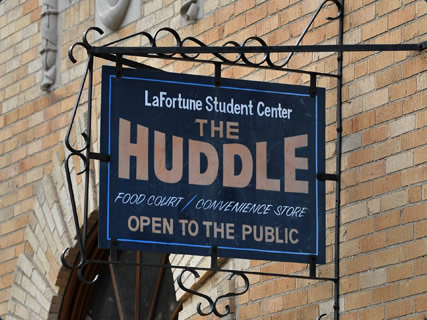Our Menu
| Item | Quantity | Price |
|---|---|---|
| Main Dishes | Hamburger | $3.50 |
| Cheeseburger | $4.00 | |
| Tacos | $2.75 | |
| Salad | $2.50 | |
| Drinks | Sodas (Coke / Sprite) | $2.00 |
| Juice | $2.50 | |
| Bottled Water | $1.25 | |
| Chips & Salsa $2 | ||

| Item | Quantity | Price |
|---|---|---|
| Main Dishes | Hamburger | $3.50 |
| Cheeseburger | $4.00 | |
| Tacos | $2.75 | |
| Salad | $2.50 | |
| Drinks | Sodas (Coke / Sprite) | $2.00 |
| Juice | $2.50 | |
| Bottled Water | $1.25 | |
| Chips & Salsa $2 | ||
Rev. Thomas E. Blantz, CSC, history professor–emeritus, assisted me with the early history of the Huddle:
Brother Leopold Kaul, “Brother Leep” as the students called him, sold cookies and lemonade out of his stand in or close to Washington Hall. This stopped about the time of World War I. Towards the end of World War I, probably 1918, the Army set up a PX in a small building between Washington Hall and the old Fieldhouse. When the war ended and the PX closed, the university bought the building for itself. In 1936, the university apparently leased it to two laymen who opened a small eatery in it and named it the “Huddle.” The university took it over in 1939 and kept the name.
The 1941 Dome compared the ambiance and offerings of the Huddle with those at the soda fountain in the Dining Hall on the South Quad, which the students called the “Caf:”

Soda fountain in “Caf” labors under 9:00 p.m. push. Two soda-jerkers, one dishwasher perform row of gleaming taps. Coke is fastest selling drink. The Huddle, serving halls on north part of campus, has other N.D. soda fountain, is smaller, has poorer appointments than “Caf” fountain, but still does whopping business, sells everything from donuts to radios.

Senior art student Michael Todd ‘57 painted the mural, which was met with scant praise. One critic referred to it as “wincing, grimacing hulks of flesh and muscle wrapped in football uniforms.” The October 1, 1970 Scholastic said:
The one [mural] in the Huddle…has had a rough go at winning an appreciative audience ever since its unveiling. The football coaches that year denounced it as repulsive, member of the Administration thought it grotesque and disgusting, and that year, and nearly every one since, the Scholastic has thrown at least dig against the work.
Robert Leader, a Notre Dame art professor, said of his student’s work:
I guess you could call it a homily on the emphasis of that kind of manliness that the artist found repulsive. Superficially it was full of the ballyhoo characteristic of Notre Dame football, and of the Huddle crowd. But that ballyhoo was no more than a disguise for the satire of the artist’s statement. Certainly it was never a beautiful piece, but that was an integral part of the message.